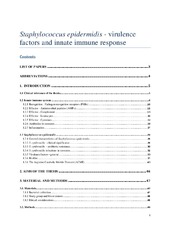| dc.contributor.advisor | Flægstad, Trond | |
| dc.contributor.author | Granslo, Hildegunn Norbakken | |
| dc.date.accessioned | 2013-03-22T12:17:22Z | |
| dc.date.available | 2013-03-22T12:17:22Z | |
| dc.date.issued | 2012-04-26 | |
| dc.description.abstract | S. epidermidis rank first among the causative agent of nosocomial infections, and accounts for more than 50% of the late-onset sepsis episodes in neonates. S. epidermidis often cause infections in immune-compromised patients
Biofilm formation is the most important virulence factor of S. epidermidis. Its relevance has risen the past decades with the increased use of indwelling medical devices such as vascular and peritoneal catheters, prosthetic joints, heart valves and vascular grafts.
The frequency of S. epidermidis infections is increasing, mainly due to concurrent advances in medical practice with more people undergoing and surviving intensive care treatment, acquiring prosthesis, and the increased survival of patients with a compromised immune system, such as preterm neonates and HIV patients.
Although S. epidermidis infections only rarely develop into life-threatening diseases, they significantly increase morbidity in the affected groups. Their frequency and the fact that they are extremely difficult to treat, represent a serious burden for the public health system.
Therefore, increased knowledge of S. epidermidis virulence factors and their impact on the innate immune system is important to develop new methods to fight these infections. | en |
| dc.description.doctoraltype | ph.d. | en |
| dc.description.popularabstract | Ved hjelp av ulike molekylærbiologiske teknikker har hun studert to mulig sykdomsfremkallende egenskaper hos S. epidermidis; Arginine Catabolic Mobile element (ACME) og biofilmproduksjon (Samfunn av bakterier omsluttet av en ekstracellulær matrix). Hun har også ved å bruke en fullblods infeksjonsmodell studert hvordan disse egenskapene hos S. epidermidis virker inn på det medfødte infeksjonsforsvaret hos friske voksne mennesker og nyfødte barn. Studien viste at ACME er en markør for «snille» bakterier som ikke bidrar til sykdom, mens biofilm-produksjon har vist seg å være en viktig faktor i utviklingen av infeksjoner tilknyttet medisinske fremmedlegemer. Biofilmen hindrer også at kroppens immunforsvar ”oppdager” infeksjonen. Nyfødte barn har ved fødselen et forsvar mot S. epidermidis biofilm infeksjoner som i utgangspunktet er dårligere enn det vi ser hos friske voksne, noe som gjør de enda mer sårbare for disse infeksjonene. | en |
| dc.description.sponsorship | Helse-Nord | en |
| dc.description | The papers and appendixes of this thesis are not available in Munin: <br/>1. Hildegunn Norbakken Granslo, Claus Klingenberg, Elizabeth Gladys Aarag Fredheim, Arild Rønnestad, Tom Eirik Mollnes, Trond Flægstad: 'The Arginine Catabolic Mobile Element is associated with low antibiotic resistance and low pathogenicity in Staphylococcus epidermidis from neonates', Pediatric Research (2010), vol. 68: 237-41. Available at <a href=http://dx.doi.org/10.1203/PDR.0b013e3181eb01e0>http://dx.doi.org/10.1203/PDR.0b013e3181eb01e0</a> <br/>2. Elizabeth G. Aarag Fredheim, Hildegunn Norbakken Granslo, Trond Flægstad, Yngve Figenschau, Holger Rohde, Irina Sadovskaya, Tom Eirik Mollnes, Claus Klingenberg: 'Staphylococcus epidermidis Polysaccharide Intercellular Adhesin Activates Complement', FEMS Immunology and Microbiology (2011), vol. 63: 269–280. Available at <a href=http://dx.doi.org/10.1111/j.1574-695X.2011.00854.x>http://dx.doi.org/10.1111/j.1574-695X.2011.00854.x</a> <br/>3. Hildegunn Norbakken Granslo, Claus Klingenberg, Elizabeth Aarag Fredheim, Ganesh Acharya, Tom Eirik Mollnes, Trond Flægstad: 'Staphylococcus epidermidis biofilms induce lower complement activation in neonates compared to adults', Pediatric Research (2013), vol. 73, 294–300. Available at <a href=http://dx.doi.org/10.1038/pr.2012.193>http://dx.doi.org/10.1038/pr.2012.193</a> <br/>Appendix: Hildegunn Granslo, Karianne W. Gammelsrud, Elizabeth A. Fredheim, Trond Flægstad, Claus Klingenberg: 'Coagulase-negative staphylococci- biofilm and antibiotic resistance', Tidsskrift for Norsk
Lægeforening (2008), vol. 128: 2746-9. Available at <a href=http://tidsskriftet.no/article/1778249>http://tidsskriftet.no/article/1778249</a> | en |
| dc.identifier.uri | https://hdl.handle.net/10037/5051 | |
| dc.identifier.urn | URN:NBN:no-uit_munin_4763 | |
| dc.language.iso | eng | en |
| dc.publisher | University of Tromsø | en |
| dc.publisher | Universitetet i Tromsø | en |
| dc.rights.accessRights | openAccess | |
| dc.rights.holder | Copyright 2012 The Author(s) | |
| dc.rights.uri | https://creativecommons.org/licenses/by-nc-sa/3.0 | en_US |
| dc.rights | Attribution-NonCommercial-ShareAlike 3.0 Unported (CC BY-NC-SA 3.0) | en_US |
| dc.subject | Staphylococccus epidermidis | en |
| dc.subject | Biofilm | en |
| dc.subject | Innate immune response | en |
| dc.subject | Complement | en |
| dc.subject | Neonates | en |
| dc.subject | Infections | en |
| dc.title | Staphylococcus epidermidis - virulence factors and innate immune response | en |
| dc.type | Doctoral thesis | en |
| dc.type | Doktorgradsavhandling | en |


 English
English norsk
norsk
